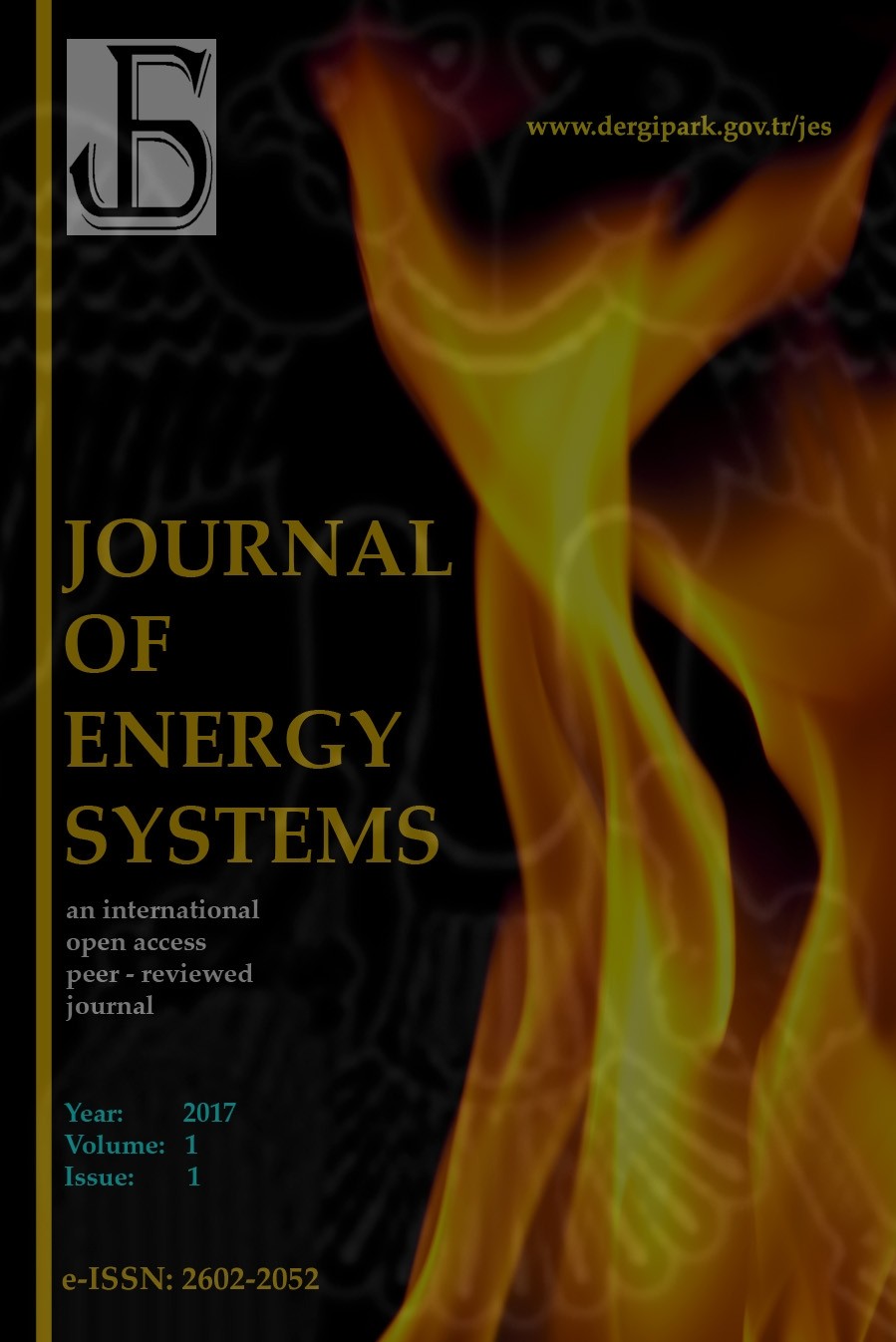Performance assessment of photovoltaic/thermal (PVT) hybrid adsorption-vapor compression refrigeration system
Performance assessment of photovoltaic/thermal (PVT) hybrid adsorption-vapor compression refrigeration system
Adsorption system, Compression system, Hybrid system, PVT,
___
- [1] Gado, MG, Megahed, TF, Ookawara, S, Nada, S, El-Sharkawy, II. Potential application of cascade adsorption-vapor compression refrigeration system powered by photovoltaic/thermal collectors. Applied Thermal Engineering 2022; 207:118075. DOI:https://doi.org/10.1016/j.applthermaleng.2022.118075.
- [2] Gado, MG, Ookawara, S, Nada, S, El-Sharkawy II. Hybrid sorption-vapor compression cooling systems : A comprehensive overview. Renewable and Sustainable Energy Reviews 2021; 143: 110912. DOI:10.1016/j.rser.2021.110912.
- [3] Gado, M, Elgendy, E, Elsayed, K, Fatouh, M. Performance enhancement of an adsorption chiller by optimum cycle time allocation at different operating conditions. Advances in Mechanical Engineering 2019; 11: 1–12. DOI:10.1177/1687814019884780.
- [4] Hassan, H, Harmand, S. Effect of using nanofluids on the performance of rotating heat pipe. Applied Mathematical Modelling 2015; 39: 4445–62. DOI:https://doi.org/10.1016/j.apm.2014.12.023.
- [5] Hassan, H, Harmand, S. 3D transient model of vapour chamber: Effect of nanofluids on its performance. Applied Thermal Engineering 2013; 51: 1191–201. DOI: https://doi.org/10.1016/j.applthermaleng.2012.10.047
- [6] C Calise, F, Figaj, RD, Vanoli, L. A novel polygeneration system integrating photovoltaic/thermal collectors, solar assisted heat pump, adsorption chiller and electrical energy storage: Dynamic and energy-economic analysis. Energy Conversion and Management 2017; 149: 798–814. DOI:10.1016/j.enconman.2017.03.027.
- [7] Gibelhaus, A, Fidorra, N, Lanzerath, F, Bau, U, Köhler, J, Bardow, A. Hybrid refrigeration by CO2 vapour compression cycle and water-based adsorption chiller: An efficient combination of natural working fluids. International Journal of Refrigeration 2019; 103: 204–14. DOI:10.1016/j.ijrefrig.2019.03.036.
- [8] Lychnos, G, Tamainot-Telto, Z. Performance of hybrid refrigeration system using ammonia. Applied Thermal Engineering 2014; 62: 560–565. DOI:10.1016/j.applthermaleng.2013.10.013.
- [9] Cyklis, P. Two stage ecological hybrid sorption-compression refrigeration cycle. International Journal of Refrigeration 2014; 48: 121–131. DOI:10.1016/j.ijrefrig.2014.08.017.
- [10] Palomba, V, Varvagiannis, E, Karellas, S, Frazzica, A. Hybrid Adsorption-Compression Systems for Air Conditioning in Efficient Buildings: Design through Validated Dynamic Models. Energies 2019; 12(6). DOI:10.3390/en12061161.
- [11] Palomba, V, Lombardo, W, Groβe, A, Herrmann, R, Nitsch, B, Strehlow, A, Bastian, R, Sapienza, A, Frazzica, A. Evaluation of in-situ coated porous structures for hybrid heat pumps. Energy 2020; 209: 118313. DOI:10.1016/j.energy.2020.118313.
- [12] Vasta, S, Palomba, V, La, Rosa D, Mittelbach, W. Adsorption-compression cascade cycles: An experimental study. Energy Conversion and Management 2018; 156: 365–375. DOI:10.1016/j.enconman.2017.11.061.
- [13] Dino, GE, Palomba, V, Nowak, E, Frazzica, A. Experimental characterization of an innovative hybrid thermal-electric chiller for industrial cooling and refrigeration application. Applied Energy 2021; 281: 116098. DOI:10.1016/j.apenergy.2020.116098.
- [14] Kilic, M, Anjrini, M. Comparative performance analysis of a combined cooling system with mechanical and adsorption cycles. Energy Conversion and Management 2020; 221: 113208. DOI:10.1016/j.enconman.2020.113208.
- [15] Gado, MG, Megahed, TF, Ookawara, S, Nada, S, El-Sharkawy II. Performance and economic analysis of solar-powered adsorption-based hybrid cooling systems. Energy Conversion and Management 2021; 238: 114134. DOI:10.1016/j.enconman.2021.114134.
- [16] Koşan, M, Akkoç, AE, Dişli, E, Aktaş, M. Design of an innovative PV/T and heat pump system for greenhouse heating. Journal of Energy Systems 2020; 4: 58–70. DOI:10.30521/jes.740587.
- [17] Karaca, G, Dolgun, EC, Kosan, M, Aktas, M. Photovoltaic-Thermal solar energy system design for dairy industry. Journal of Energy Systems 2019; 3: 86–95. DOI:10.30521/jes.565174.
- [18] El-Sharkawy II, AbdelMeguid, H, Saha, BB. Potential application of solar powered adsorption cooling systems in the Middle East. Applied Energy 2014; 126: 235–45. DOI:10.1016/j.apenergy.2014.03.092.
- [19] Gado, MG, Megahed, TF, Ookawara, S, Nada, S, El-Sharkawy II. Energetic analysis of a PVT-based solar-driven hybrid adsorption-compression refrigeration system. In: ECRES 2021 9th Eur. Conf. Ren. Energy Sys.; 21-23 April 2021: dhepublisher, pp. 171–176.
- [20] Gado, MG, Nasser, M, Hassan, AA, Hassan, H. Adsorption-based atmospheric water harvesting powered by solar energy: Comprehensive review on desiccant materials and systems. Process Safety and Environmental Protection 2022; 160: 166–83. DOI:10.1016/J.PSEP.2022.01.061.
- [21] Gado, MG, Ookawara, S, Nada, S, Hassan, H. Renewable energy-based cascade adsorption-compression refrigeration system: Energy, exergy, exergoeconomic and enviroeconomic perspectives. Energy 2022:124127. DOI:https://doi.org/10.1016/j.energy.2022.124127.
- [22] Gado, MG, Megahed, TF, Ookawara, S, Nada, S, El-Sharkawy II. Parametric study of a hybrid adsorption-vapor compression cooling system. In: 3rd International conference of Chemical, Energy and Environmental Engineering, 27-28 July 2021: Alexandria, Egypt, pp. 1–6.
- [23] Saha, BB, Boelman, EC, Kashiwagi, T. Computer simulation of a silica gel-water adsorption refrigeration cycle - the influence of operating conditions on cooling output and COP. ASHRAE Transactions 1995; 101: 348–57.
- [24] Gado, MG, Elgendy, E, Elsayed, K, Fatouh, M. Parametric Study of an Adsorption Refrigeration System Using Different Working Pairs. International Conference on Aerospace Sciences and Aviation Technology 2017; 17: 1–15. DOI:10.21608/asat.2017.22455.
- [25] Gado, MG, Nada, S, Ookawara, S, Hassan, H. Energy management of standalone cascaded adsorption-compression refrigeration system using hybrid biomass-solar-wind energies. Energy Conversion and Management 2022; 258:115387. DOI:https://doi.org/10.1016/j.enconman.2022.115387.
- Başlangıç: 2017
- Yayıncı: Erol KURT
Future value creation of German energy companies through smart home applications
Andreas ENSİNGER, Max Robert SALZER, Karlheinz BOZEM, Anna NAGL, David Keith HARRİSON, Bruce Macleod WOOD
Mohd Faısal KHAN, Mohd Rizwan KHAN
Mohamed GADO, Shinichi OOKAWARA, Sameh NADA, Hamdy HASSAN
Model predictive control stabilization of a power system including a wind power plant
Islam Ahmed ALİ, Abdel Latif ELSHAFEİ
The simulation of a new high frequency transformer
Fixed and adjusted optimal tilt angle of solar panels in three cities in Albania
Urim BUZRA, Driada MİTRUSHİ, Eduart SERDARİ, Daniela HALİLİ, Valbona MUDA
Nabaz Mohammedalı RASOOL, Serkan ABBASOĞLU, Mehrshad HASHEMIPOUR
Sumeet Kumar DUBEY, K Ravi KUMAR
Investigation of the performance of ground-coupled heat exchanger technology for tempering air
Mahendra GOOROOCHURN, Maheshsingh MUNGUR, Heman SHAMACHURN, Yashwansingh SURNAM, Fardeen MANDARKHAN, Devin BHOODOO
